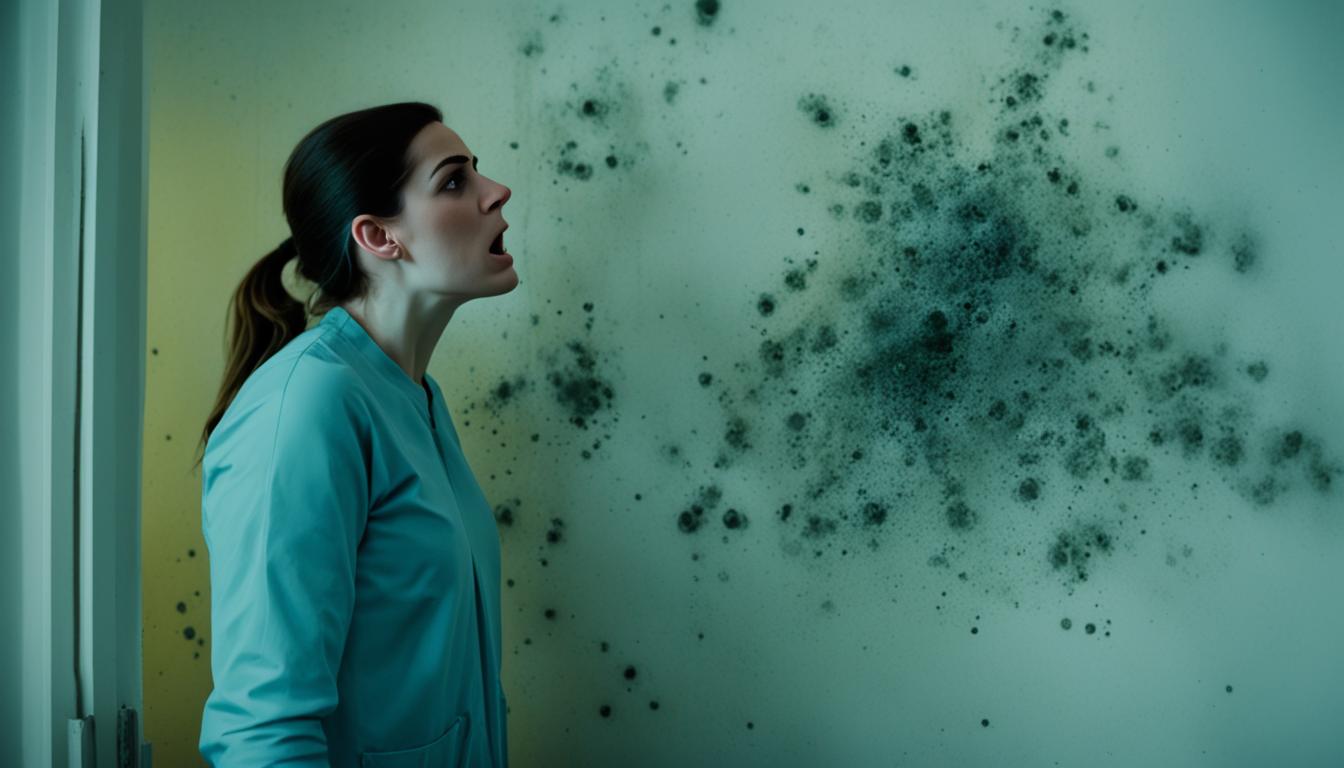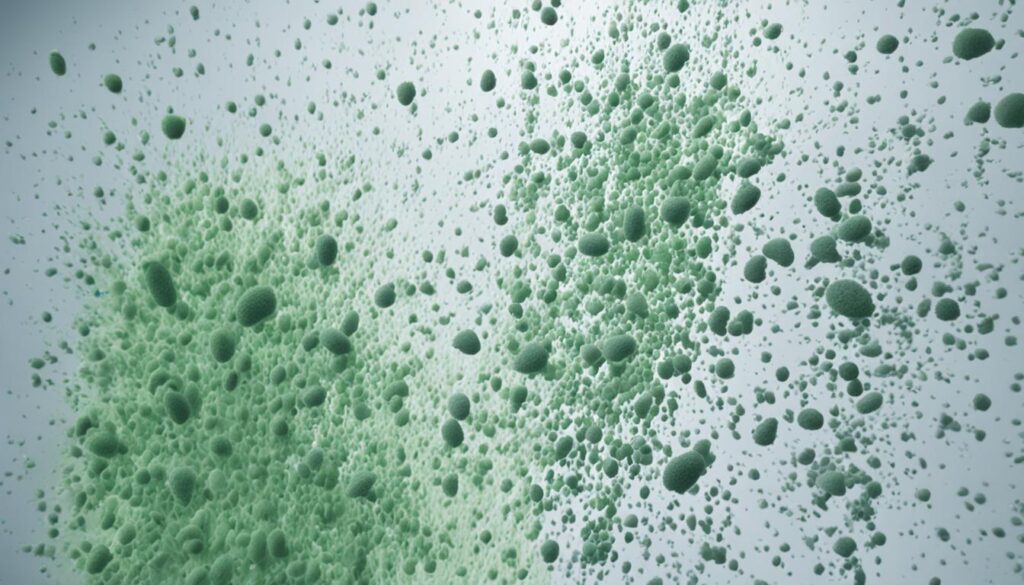
Side Effects of Mold Exposure: Risks & Health Issues
Mold exposure can have severe consequences for individuals’ health and well-being. Understanding the potential side effects is essential for taking proactive measures and safeguarding oneself from these risks. In this section, we will explore the various health risks associated with mold exposure and delve into the detrimental effects it can have on overall well-being.
Key Takeaways:
- Mold exposure can trigger allergic reactions and worsen existing respiratory conditions like asthma.
- Infections and toxic reactions can occur due to prolonged exposure to mold.
- Mold exposure can lead to fatigue, headaches, and difficulty concentrating.
- Psychological distress, including anxiety and depression, can be a side effect of mold exposure.
- Preventive measures and professional assistance can help address and mitigate mold growth.
Health Risks of Mold Exposure
Mold exposure can have significant health risks that should not be taken lightly. It can trigger allergic reactions, especially in individuals with pre-existing allergies or asthma. Symptoms like sneezing, coughing, and itching may arise as a result of mold exposure. These allergic reactions can be uncomfortable and disruptive to daily life.
Prolonged exposure to mold can lead to respiratory issues, which can have a serious impact on overall well-being. Individuals may experience difficulty breathing, chest tightness, and worsened asthma symptoms. Mold spores can irritate the respiratory system and cause inflammation, further exacerbating respiratory problems.
However, the health risks of mold exposure go beyond allergic reactions and respiratory issues. Mold can also lead to infections and toxic reactions in the body. Certain types of mold produce mycotoxins, which are harmful substances that can affect various body systems. Exposure to these mycotoxins can result in neurological symptoms, skin irritation, and even organ damage.
The Link between Mold and Allergies/Asthma
People with allergies or asthma are more susceptible to the health risks of mold exposure. Mold spores act as allergens, triggering immune responses in individuals with allergies. For those with asthma, exposure to mold can worsen their symptoms and lead to severe asthma attacks.
The presence of mold in indoor environments can be particularly problematic for individuals with allergies or asthma. It is crucial for these individuals to take extra precautions to prevent mold growth and reduce exposure. Regular cleaning, proper ventilation, and maintaining optimal humidity levels can help minimize the risks associated with mold.
It is important to be aware that mold can affect everyone differently. Some individuals may be more sensitive to mold than others, and the severity of health risks can vary. However, it’s always better to err on the side of caution and address mold issues promptly to safeguard health.
Mold-Induced Infections and Toxins
Certain types of mold can cause infections, especially in individuals with weakened immune systems. These infections can affect various parts of the body, such as the skin, lungs, and sinuses. Fungal infections, like aspergillosis or mucormycosis, can be serious and require medical intervention.
In addition to infections, mold can also produce mycotoxins, which are toxic substances. Mycotoxins can enter the body through inhalation or skin contact. The effects of mycotoxin exposure can range from minor irritations to severe toxic reactions, depending on the type and concentration of the mycotoxin.

| Health Risks | Symptoms |
|---|---|
| Allergic reactions | Sneezing, coughing, itching |
| Respiratory issues | Difficulty breathing, chest tightness, worsened asthma symptoms |
| Infections | Fungal infections in skin, lungs, sinuses, etc. |
| Toxic reactions (from mycotoxins) | Neurological symptoms, skin irritation, organ damage |
Monitoring and addressing mold issues promptly are key to minimizing the health risks associated with mold exposure. Seeking professional help for mold assessment and remediation is recommended, especially for severe cases of mold infestation.
Side Effects on Well-being
Exposure to mold can have significant side effects on overall well-being. Not only does it impact physical health, but it also affects mental and emotional aspects, diminishing an individual’s quality of life.
One of the common side effects of mold exposure is fatigue. Individuals who are exposed to mold may experience constant tiredness and lack of energy, making it difficult to engage in daily activities.
Headaches are also prevalent among those exposed to mold. Whether it’s mild or severe, persistent headaches can disrupt concentration and overall productivity, affecting an individual’s well-being and ability to perform at their best.
Mold exposure can further lead to difficulties in concentration. The presence of mold spores in the environment can impair cognitive function, making it challenging to focus, retain information, and complete tasks efficiently.
Beyond the physical symptoms, mold exposure can also have psychological implications. Research has shown that individuals exposed to mold are more likely to experience anxiety and depression. The constant worry about the effects of mold on health, coupled with the impact on physical well-being, can contribute to increased levels of stress and mental distress.
Understanding the diverse ways in which mold exposure affects well-being is crucial for individuals to take appropriate measures to mitigate the risks. By addressing and preventing mold growth in homes and workplaces, individuals can create a healthier environment that supports their overall well-being.
The Importance of Well-being in Mold Prevention
Recognizing the significant impact of mold exposure on well-being highlights the need for proactive measures to prevent mold growth. By prioritizing well-being and implementing effective strategies, individuals can safeguard their health.
“Well-being is not just the absence of illness or disease, but the state of complete physical, mental, and social well-being.”
Preventive actions, such as controlling moisture levels, improving ventilation, and promptly addressing any signs of water damage or leaks, are essential in preventing mold growth. By maintaining a dry and well-ventilated environment, individuals can minimize the conditions favorable for mold development.
Regular inspections, both indoors and outdoors, can help identify and address any potential mold sources before they become a health hazard. This includes checking for leaks, monitoring humidity levels, and addressing any water accumulation or dampness promptly.
Furthermore, maintaining a clean and clutter-free environment can reduce the risk of mold growth. Regular cleaning and drying of surfaces, along with proper storage practices, can help minimize the accumulation of moisture and prevent mold from thriving.
Investing in professional mold assessments and remediation services, such as those offered by reputable companies like Fix Mold Miami, can provide peace of mind and ensure thorough mold prevention and removal.
Strategies for Preventing Mold Growth
| Preventive Measures | Benefits |
|---|---|
| Control moisture levels | – Creates an unfavorable environment for mold growth – Reduces the risk of mold-related health issues |
| Improve ventilation | – Enhances air circulation and prevents humidity build-up – Reduces the chances of mold development |
| Promptly address water damage and leaks | – Prevents mold growth by eliminating water sources – Minimizes the risk of structural damage |
| Regular inspections | – Allows for early detection and prevention of mold growth – Ensures a healthier living or working environment |
| Maintain cleanliness and organization | – Reduces the potential for moisture accumulation – Limits the presence of hidden mold sources |
| Seek professional mold assessments and remediation | – Ensures comprehensive evaluation and effective mold removal – Provides expert guidance for maintaining a mold-free environment |
By implementing these preventive measures, individuals can create a mold-resistant environment that promotes overall well-being and reduces the risk of mold-related health issues.

Conclusion
In conclusion, mold exposure can have serious implications for both the health and well-being of individuals. The various risks and side effects associated with mold exposure highlight the importance of being proactive in addressing this issue. By understanding the potential health hazards and taking appropriate preventive measures, individuals can safeguard themselves and their loved ones from the detrimental effects of mold.
If you suspect the presence of mold in your environment, it is crucial to seek professional help for mold assessments and remediation. Companies like Fix Mold Miami have the expertise and experience to identify and address mold problems effectively. Taking prompt action can help mitigate the risks and ensure a healthy and safe living environment.
By being vigilant about mold prevention and proactive in addressing any signs of mold growth, individuals can protect their health, well-being, and quality of life. It is essential to prioritize a mold-free environment to minimize the potential health risks and enjoy a safe and comfortable living space for years to come.




